species in honey and bumble bee nests probably neutral to beneficial; predatory on microarthropods in nest; species in stingless bee nests not well known
Hypoaspis Canestrini, 1884
Superorder Parasitiformes » Order Mesostigmata » Suborder Monogynaspida » Hyporder Dermanyssiae » Family Laelapidae » Genus Hypoaspis
Gamasus krameri G. & R. Canestrini, 1881
Systematics of this genus is unsettled and in need of revision, using both morphology and molecular data.
Females of bee-associated species of Hypoaspis can be diagnosed based mostly on general (and probably plesiomorphic) traits as follows: Dorsal idiosomaidiosoma:
Body not including the gnathosoma.
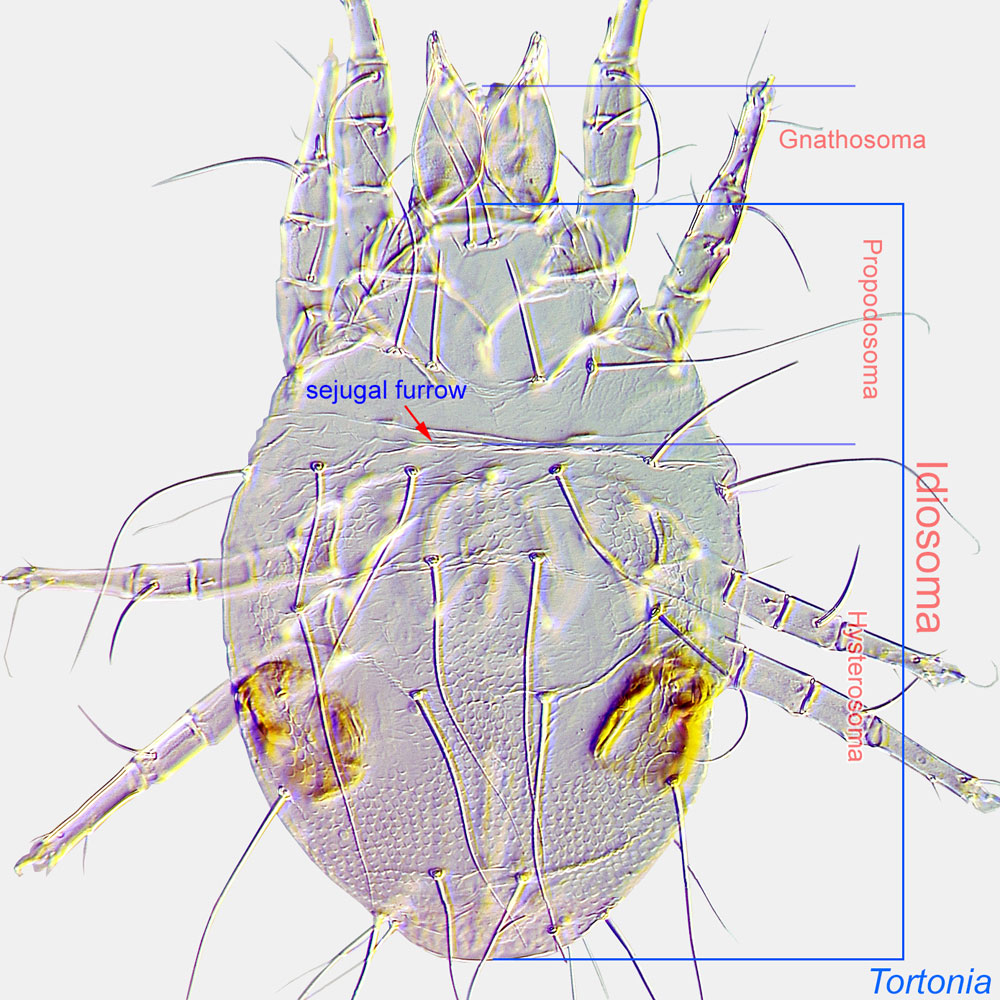 and opisthosomal venter not hypertrichoushypertrichous:
and opisthosomal venter not hypertrichoushypertrichous:
With many irregularly arranged setae.
(Figs 1, 2). Marginal idiosomal setae with pointed ends (Figs 1, 2). Epigynal and anal shieldsanal shield:
In Mesostigmata, a ventral shield bearing the anal opening and circumanal setae (adanal or postanal setae), but without any ventral setae or pores (lyrifissures) on it. If ventral setae are present on shield than referred to as a ventrianal shield.
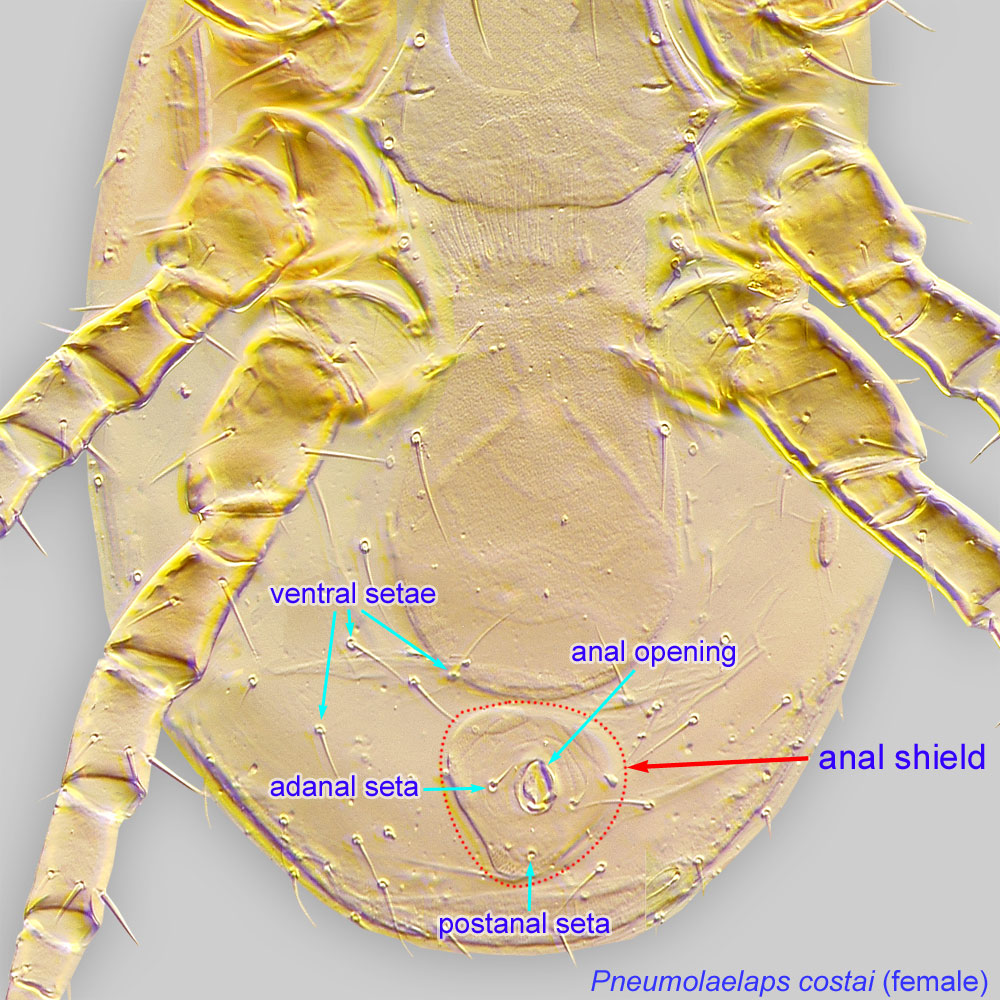 well separated (except for Hypoaspis favosa, where they are nearly touching each other) (Figs 2, 9). Sternal shieldsternal shield:
well separated (except for Hypoaspis favosa, where they are nearly touching each other) (Figs 2, 9). Sternal shieldsternal shield:
A shield in the anterior intercoxal region of parasitiform mites that bears one or more pairs of sternal setae.
 not expanded anteriorly and does not form a tubercle (Figs 7, 8). Anterior edge of sternal shieldsternal shield:
not expanded anteriorly and does not form a tubercle (Figs 7, 8). Anterior edge of sternal shieldsternal shield:
A shield in the anterior intercoxal region of parasitiform mites that bears one or more pairs of sternal setae.
 simplesimple:
simplesimple:
Of claws or setae; not modified or not bi- or trifurcate at tip.
, not forming additional shield (Fig. 7). Posterior margin of sternal shieldsternal shield:
A shield in the anterior intercoxal region of parasitiform mites that bears one or more pairs of sternal setae.
 not deeply concave (variable in non-bee-associated species) (Fig. 7). Presternal shieldsPresternal shield:
not deeply concave (variable in non-bee-associated species) (Fig. 7). Presternal shieldsPresternal shield:
Small, paired sclerotized plates anterior to the sternal shield and laterad or posteriad the base of the tritosternum in some Mesostigmata. Also known as presternal platelets.
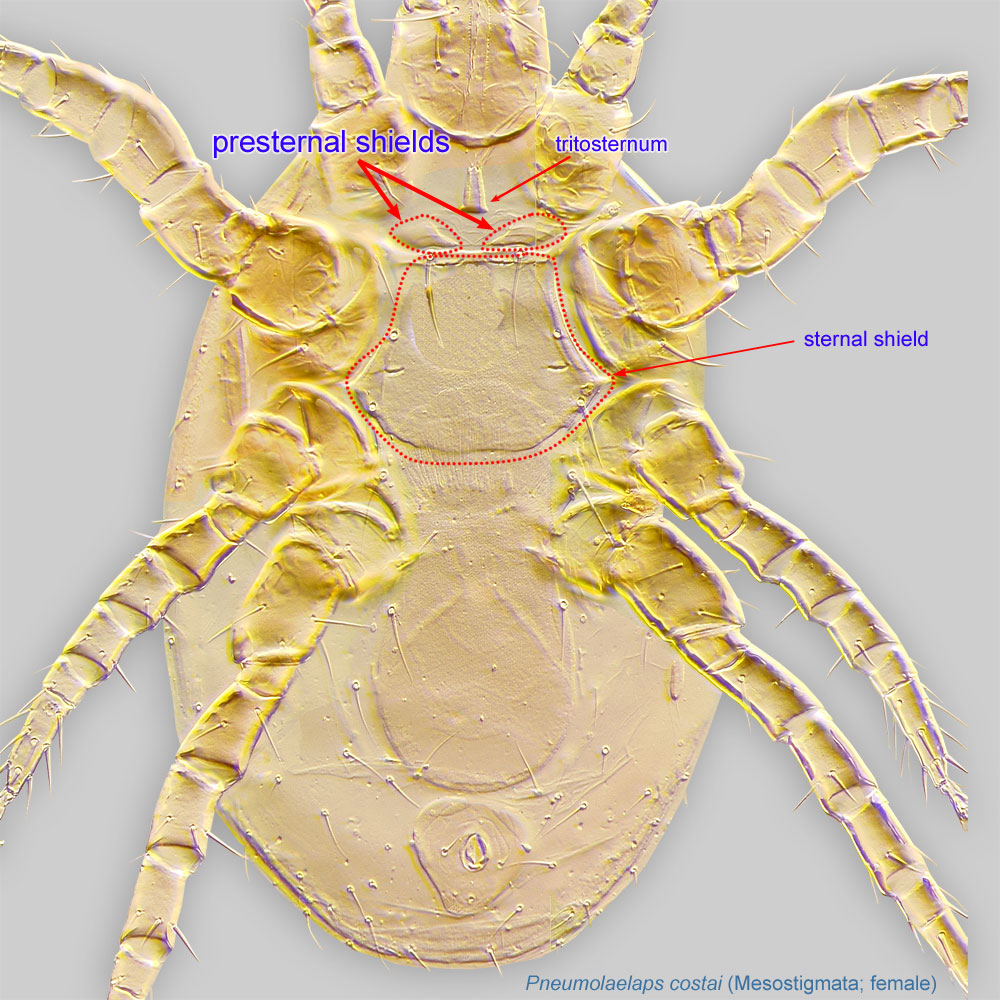 not fused with sternal shieldsternal shield:
not fused with sternal shieldsternal shield:
A shield in the anterior intercoxal region of parasitiform mites that bears one or more pairs of sternal setae.
 (Fig. 8). Epigynal shieldepigynal shield:
(Fig. 8). Epigynal shieldepigynal shield:
A shield protecting the female genital opening. Well-developed in Mesostigmata. Also known as epigynial shield.
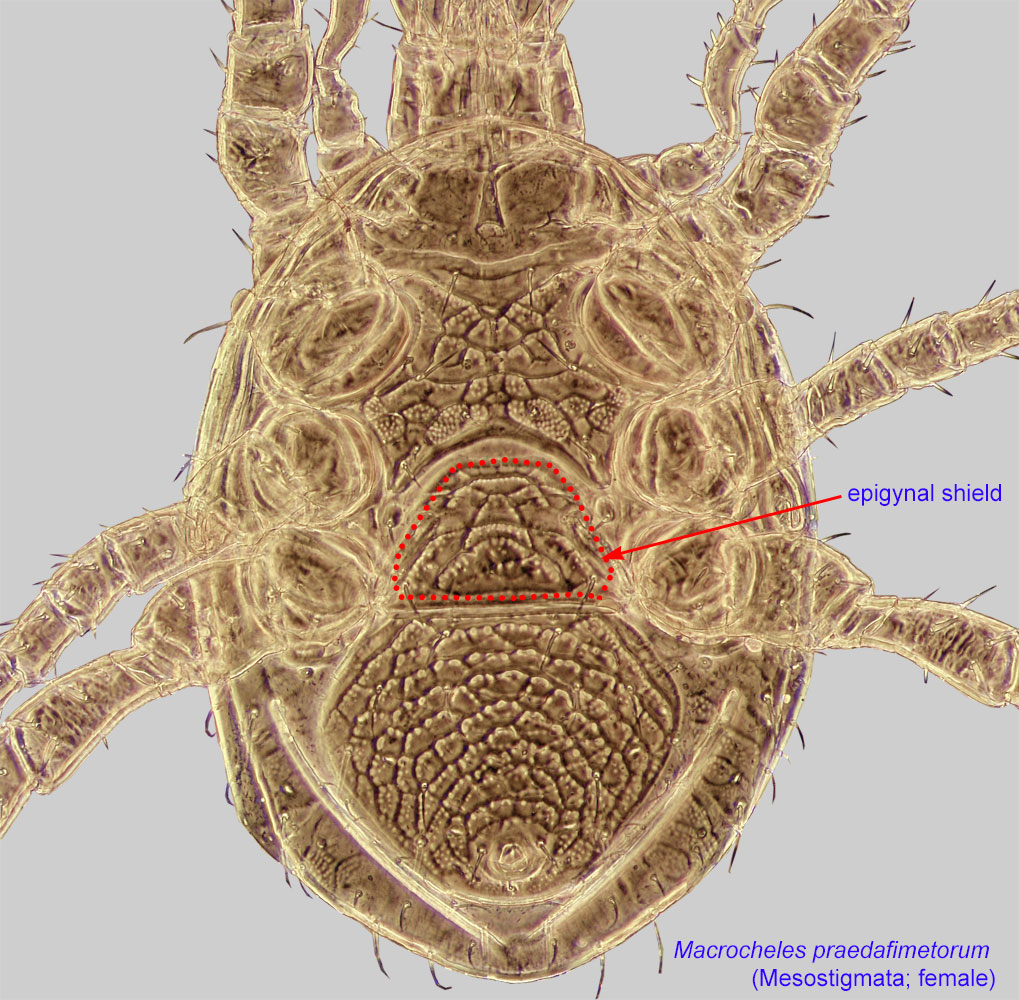 not narrowing posteriorly and not pointed; anal shieldanal shield:
not narrowing posteriorly and not pointed; anal shieldanal shield:
In Mesostigmata, a ventral shield bearing the anal opening and circumanal setae (adanal or postanal setae), but without any ventral setae or pores (lyrifissures) on it. If ventral setae are present on shield than referred to as a ventrianal shield.
 not kidney-shaped (Fig. 9). Peritrematic shield extends beyond stigma (Fig. 12). Width of stigma subequal to base of tritosternumtritosternum:
not kidney-shaped (Fig. 9). Peritrematic shield extends beyond stigma (Fig. 12). Width of stigma subequal to base of tritosternumtritosternum:
In Mesostigmata, a biflagellate structure situated on the ventral side of the body, posterior to the gnathosoma and anterior to the sternal shield. Sometimes the flagellae (laciniae) are partially or completely fused. 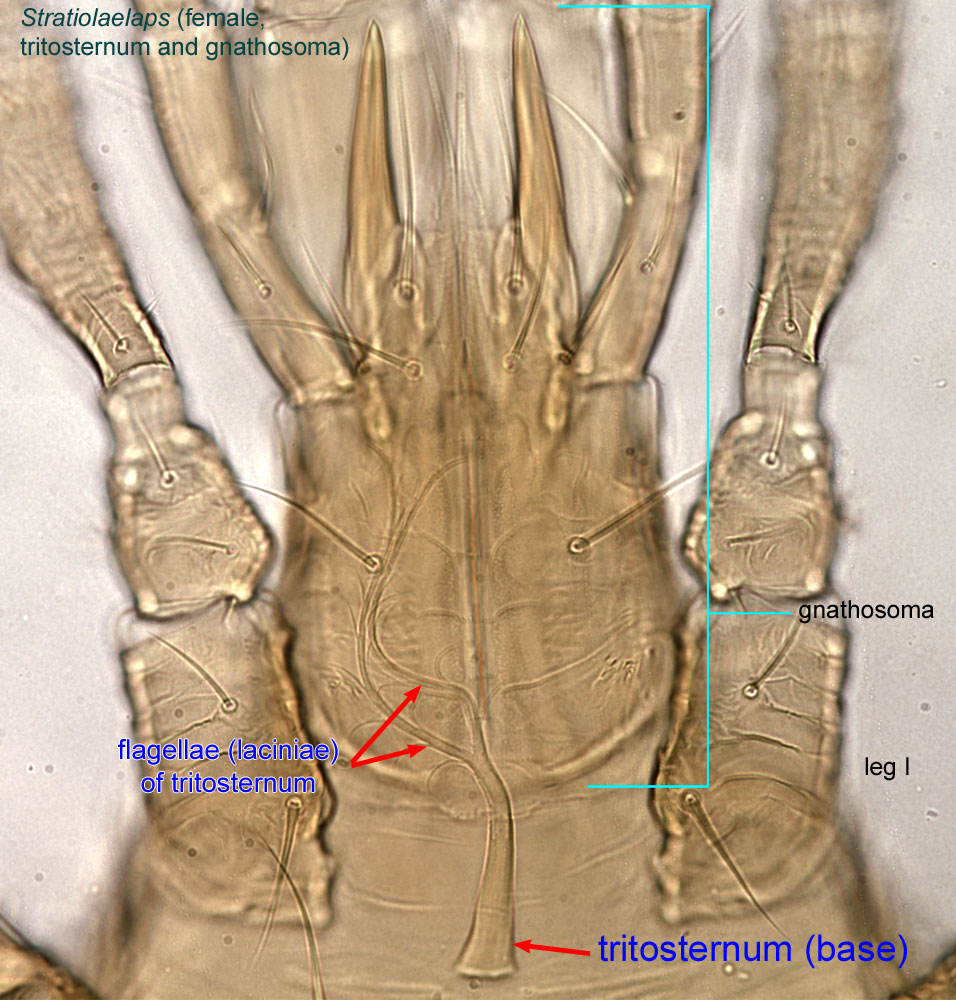 (=stigma not enlarged) (Fig. 12). PeritremesPeritreme:
(=stigma not enlarged) (Fig. 12). PeritremesPeritreme:
Paired, tubular, elaborated extensions of a tracheal system associated with stigmatic openings. Can be chambered, arch-like, and situated on the bases of chelicerae as in Cheyletidae (Prostigmata) or, in Mesostigmata, linear and situated on the lateral sides of the body.
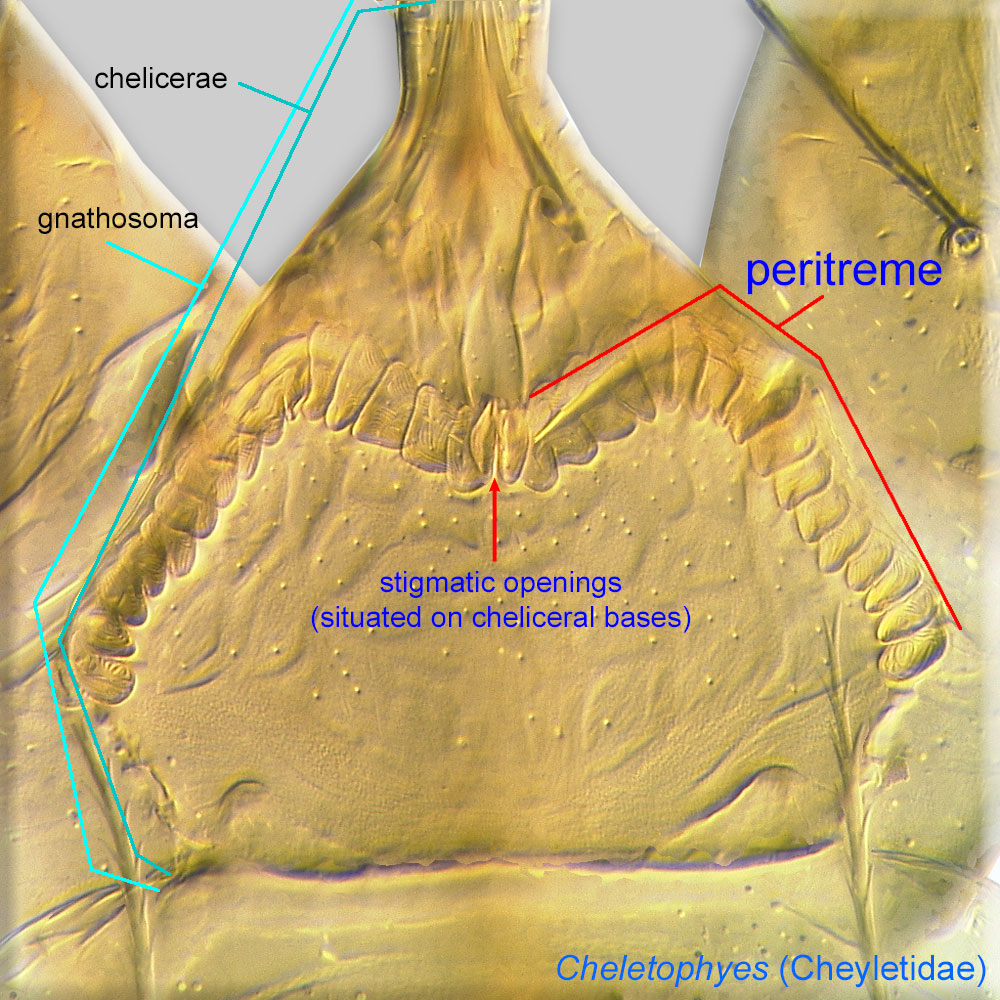 long, extending anteriorly beyond legs II (Fig. 13).
long, extending anteriorly beyond legs II (Fig. 13).
Species of Hypoaspis known from bees by can be grouped as follows:
 (two presternal shieldspresternal shield:
(two presternal shieldspresternal shield: fused together). Posterior margin of epigynal shieldepigynal shield:
fused together). Posterior margin of epigynal shieldepigynal shield: near anal shieldanal shield:
near anal shieldanal shield: . Represented by H. favosa.
. Represented by H. favosa. with characteristic anterior margin straight or concave. Represented by H. alphabetica, H. hoffmannae, H. meliponarum, and undescribed species illustrated here (Figs 1-20). Furthermore, the two species from Asian stingless bees (H. hoffmannae and the undescribed species) have a single tooth on each row of deutosternal groove (Figs 16, 18, 20) and enlarged pilus dentilispilus dentilis:
with characteristic anterior margin straight or concave. Represented by H. alphabetica, H. hoffmannae, H. meliponarum, and undescribed species illustrated here (Figs 1-20). Furthermore, the two species from Asian stingless bees (H. hoffmannae and the undescribed species) have a single tooth on each row of deutosternal groove (Figs 16, 18, 20) and enlarged pilus dentilispilus dentilis:Species-rich genus with unclear boundaries (see "Diagnosis" topic above). Most generalist species can be identified using Evans and Till, 1966Evans and Till, 1966:
Evans, G. O. amp; W. M. Till. 1966. Studies on the British Dermanyssidae (Acari: Mesostigmata) Part II. Classification. Bulletin of the British Museum (Natural History) Zoology. 14: 107-370.; Bregetova, 1977aBregetova, 1977a:
Bregetova, N. G. 1977a. [Family Laelaptidae]. In [Opredelitel' obytayshchikh v pochve kleshchey Mesostigmata = Identification key to soil-inhabiting mites Mesostigmata], eds. M. S. Gilarov amp; N. G. Bregetova, 483-554. Leningrad: Nauka.; Karg, 1982Karg, 1982:
Karg, W. 1982. Zur Kenntnis der Raubmilbeng Hypoaspis Canestrini, 1884 (Acarina, Parasitiformes). Mitteilungen aus dem Zoologischen Museum in Berlin. 58:233-256.. The most recent review of generic concepts involving this genus is in Beaulieu, 2009Beaulieu, 2009:
Beaulieu, F. 2009. Review of the mite genus Gaeolaelaps Evans amp; Till (Acari: Laelapidae), and description of a new species from North America, G. gillespiei n. sp. Zootaxa. 2158: 33-49..
Holarctic (Group 1); Neotropical region (Group 2), Neotropical and Oriental regions (Groups 2 and 3).
honey bees (Apis), bumble bees (Bombus), and stingless bees (Meliponini)
group 1 facultativefacultative:
can complete entire life cycle without bees or their close relative, wasps
; groups 2 and 3 probably permanent
group 1 (see Diagnosis)
groups 2, 3
unknown for bee-associated mites